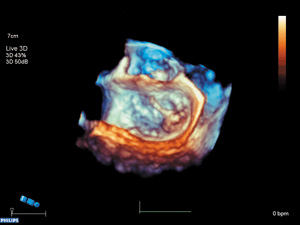See the heartbeat
By Rose Schapiro, ’09
Image courtesy of Philips Corporation
On his desktop computer, cardiologist Roberto Lang watches a video that shows, in moving detail, the mitral valve of a potential surgical patient: opening and closing, the valve pumps blood through the heart. Through a new procedure known as three-dimensional transesophageal echocardiography (3D TEE), doctors can travel inside a patient’s chest to see how the heart is pumping and where exactly its defects lie.

Generating a nearly complete image of the heart, the 3D TEE picture is almost “identical to what the surgeon sees when he operates,” says Lang, who helped develop 3D TEE. With fellow Chicago cardiologist Lissa Sugeng, Lang reported on it in the August 2008 Journal of the American College of Cardiology, noting that the relatively noninvasive procedure, performed without opening the chest, can monitor the heart before, during, and after surgery.
The 3D TEE pictures are supplied by “a little camera mounted at the tip of a gastroscope,” explains Lang. The patient swallows the gastroscope, which uses fiber-optic cables to transport information—in real time—through the esophagus to the computer that processes the images. Earlier cameras, some with fewer than 100 sensors, allowed only two-dimensional images and suffered interference from the lungs because they could only be used externally. Cardiologists would have to mentally construct a 3-D picture out of several 2-D images to determine where the defects were and how to operate.
With 2,000 to 3,000 sensors, the new probe is only an inch around and provides what Lang calls “exquisite detail.” Before the 3D TEE arrived in 2007, aided by computers fast enough to process the information from the sensors, Sugeng adds, “it was always a visual guesstimation to see the heart.”
Developed by the Philips Corporation and tested by Lang, Sugeng, and the Medical Center’s surgical team on patients through the diagnostic and surgical process, 3D TEE is now being marketed to other hospitals, where Sugeng expects it to do well. “While three-dimensional pictures are beautiful,” she says, the important information comes from the “data and the data set that the pictures can provide.”
Return to top